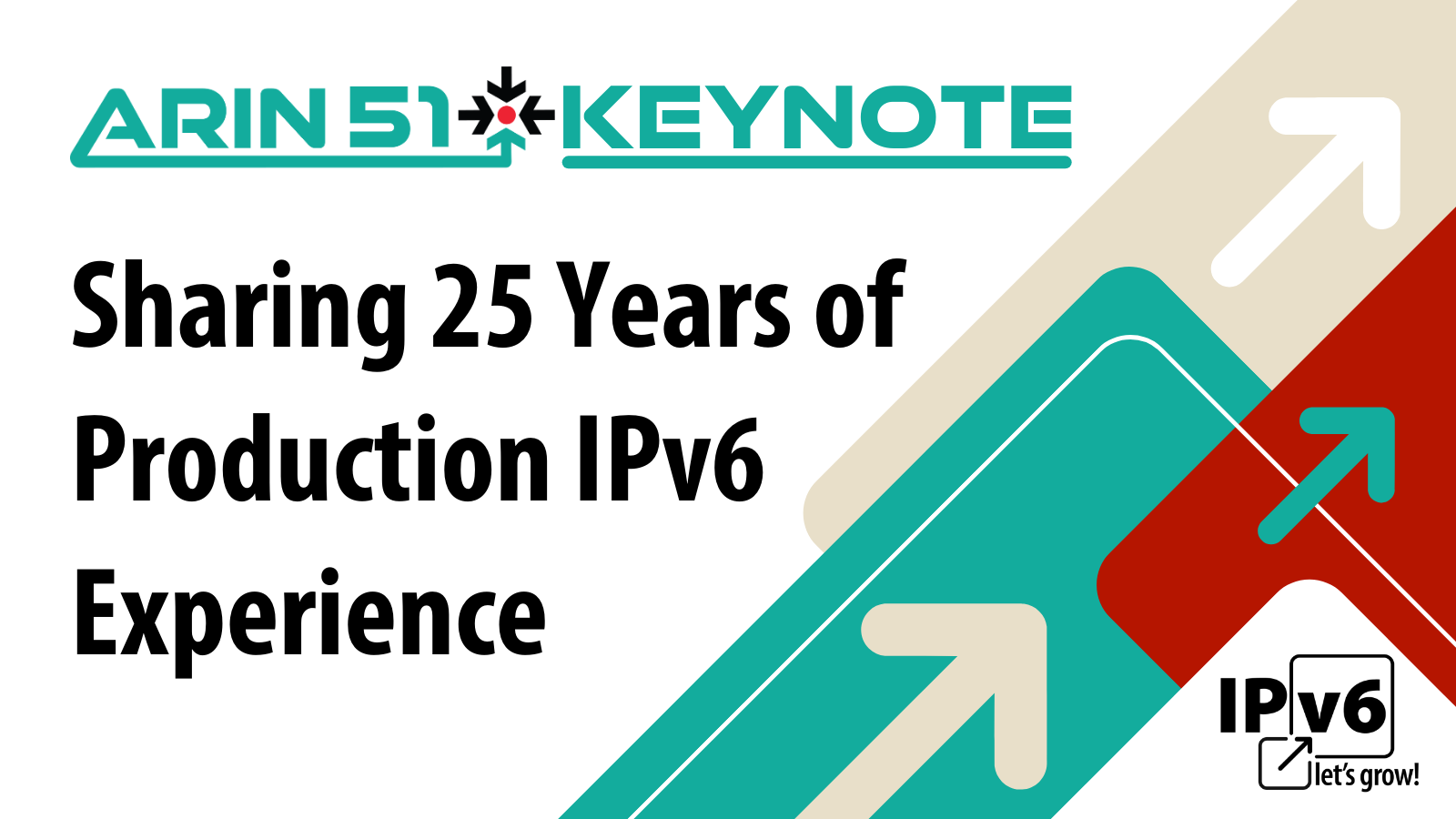
ARIN 51 Keynote Address Shares 25 Years of Production IPv6 Experience
Last month at the ARIN 51 Public Policy and Members Meeting we offered an exciting lineup of IPv6 programming, beginning with the IPv6 Success Stories keynote address. The session celebrated 25 years of production IPv6 at Virginia Tech with some of the engineers who made it happen. Here’s a summary of the insightful presentation and details on where you can watch the full keynote for yourself.
Hosted on Day Two of ARIN 51, the keynote featured the following Virginia Tech IT staffers sharing about their early adoption of IPv6, the challenges and successes they experienced along the way, and their advice for others deploying IPv6:
- Dr. Scott Midkiff – Professor, Vice President for Information Technology, Chief Information Officer (CIO)
- Phil Benchoff – Senior Escalation Engineer
- Eric Brown – Senior Network Architect
- Brian Jones – Director of Operations (ARIN Advisory Council member)
A Brief History
Dr. Scott Midkiff, who was a faculty member in the Bradley Department of Electrical and Computer Engineering (ECE) and on the team that led to Virginia Tech’s production deployment of IPv6 in 1998, opened the keynote by explaining how the deployment began.
When ECE Ph.D. students began working with network engineers from the university’s IT organization to explore, test, and deploy IPv6, former CIO Erv Blythe recognized that they had an important opportunity to advance innovation and research competitiveness. IT and the ECE department then worked together to move the technology from a somewhat immature state into practice.
“It allowed Virginia Tech to skate to where the puck is going to be,” Scott said, “to use the often-quoted phrase from Wayne Gretzky.”
Touching on other ways in which Virginia Tech remains committed to innovation and research competitiveness, including working with the Commonwealth Cyber Initiative to enable Virginia researchers to advance next-generation wireless networks, Scott emphasized that the university continues its commitment to IPv6 by working with vendors and other institutions to make universal deployment a reality.
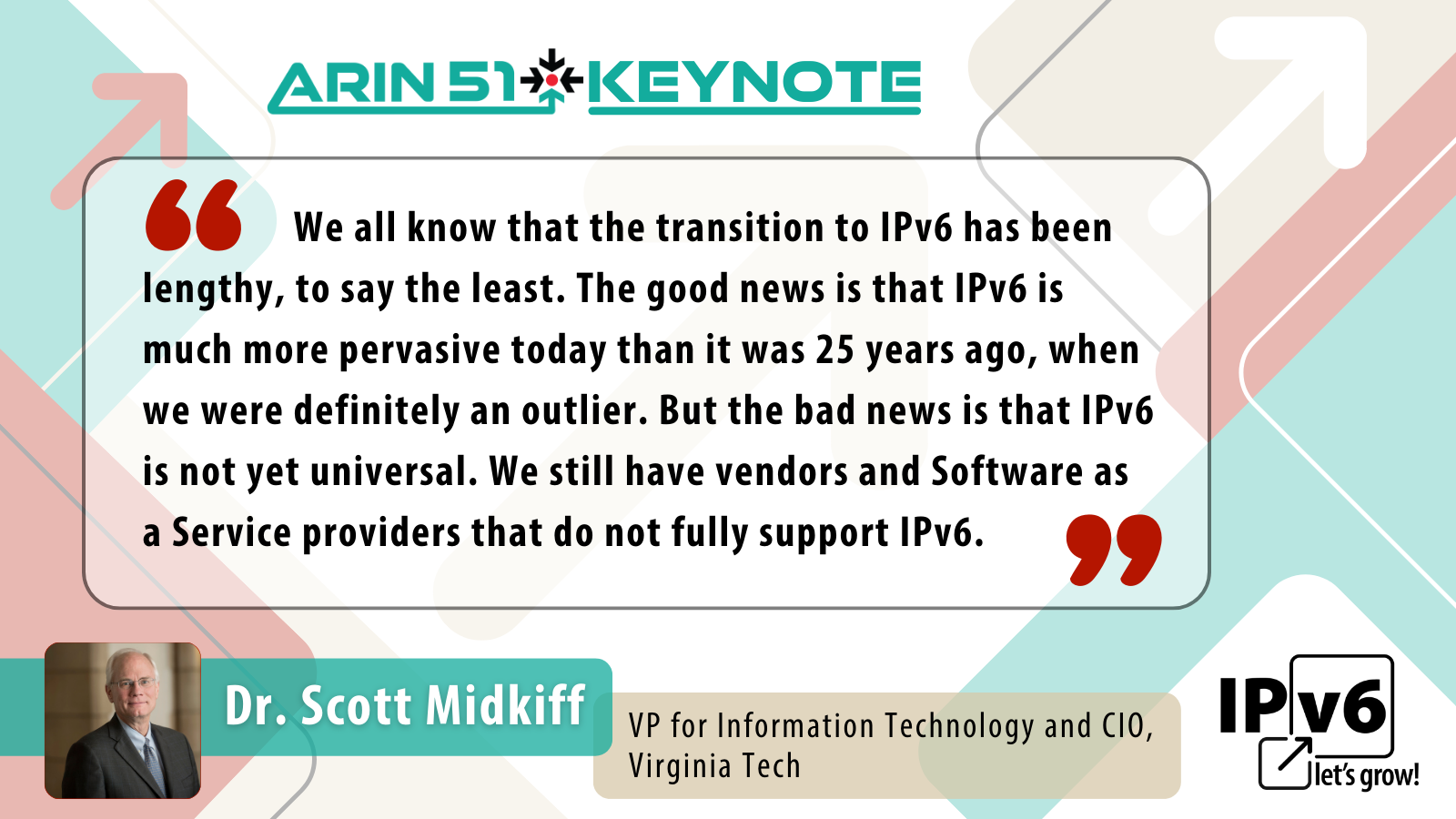
“We all know that the transition to IPv6 has been lengthy, to say the least,” Scott said. “The good news is that IPv6 is much more pervasive today than it was 25 years ago, when we were definitely an outlier. But the bad news is that IPv6 is not yet universal. We still have vendors and Software as a Service providers that do not fully support IPv6.”
A Road Map for the Next 25 Years
Phil Benchoff, who started working with IPv6 around 1997, presented next to share some of what he’s learned. He began by encouraging others in their IPv6 journeys: “We have definitely put time and effort into IPv6. But it was nowhere close to the hardest and most labor-intensive things we have done. Paying attention to incremental deployment and risk management has minimized the costs and spread them out over a long time.”
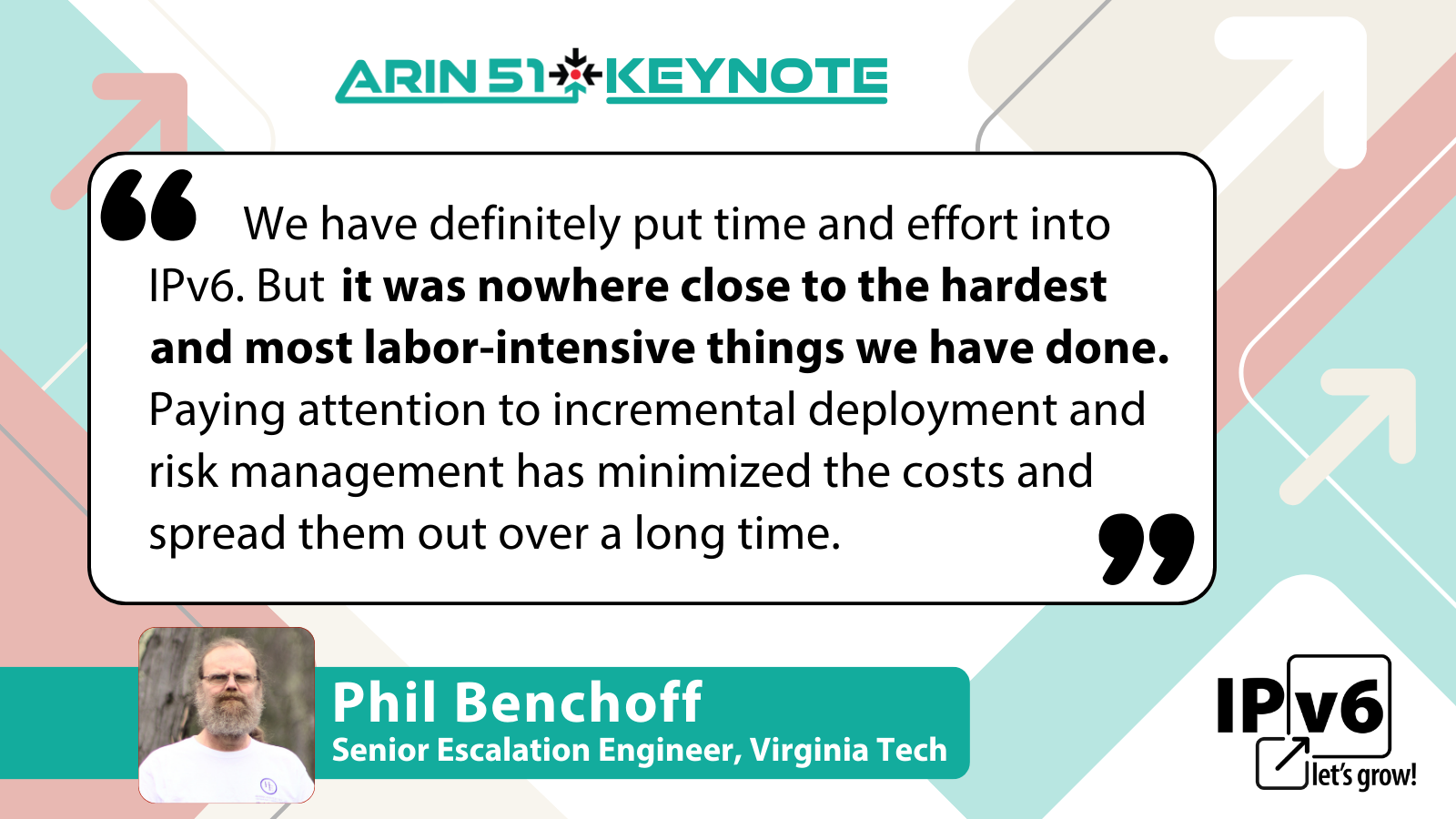
Noting that many of the most difficult-to-deploy technologies are long gone, Phil explained that making progress today is more about asking vendors the right questions and testing than about obscure technical issues.
Phil continued by outlining an “IPv6 for Everyone” road map, sharing what organizations can do today to make progress in their deployment at any stage: ask, test, and have the mindset and goal of making things work on an IPv6-only network.
Step 1: Ask
“Sooner or later you’re going to start using IPv6,” Phil said. “And everything you buy today that does not support IPv6 is eventually going to have to be dealt with in one way or the other.” The takeaway? Asking about IPv6 in your procurement process is one of the most important steps in deployment; don’t let “Nobody asked about it” be your vendor’s excuse. If they don’t support IPv6, ask for their road map — and consider what else they might have been ignoring when they were ignoring IPv6.
“The way you think and talk about IPv6 helps make sure expectations are clear to vendors and others within your organization,” Phil said. “And I think you should question a vendor’s commitment to IPv6 if their primary website does not support IPv6. This has actually been a pretty reliable indicator for more than a decade.”
Have the Right Mindset
Speaking of the way you think, Phil next focused on the importance of treating IPv6 with the right mindset or attitude. He shared his personal approach of thinking about what you want the network to be — an IPv6 network — and not what you have to put up with in the interim. “IPv6 should be viewed not as an option or an add-on,” he said. “It should be there by default.”
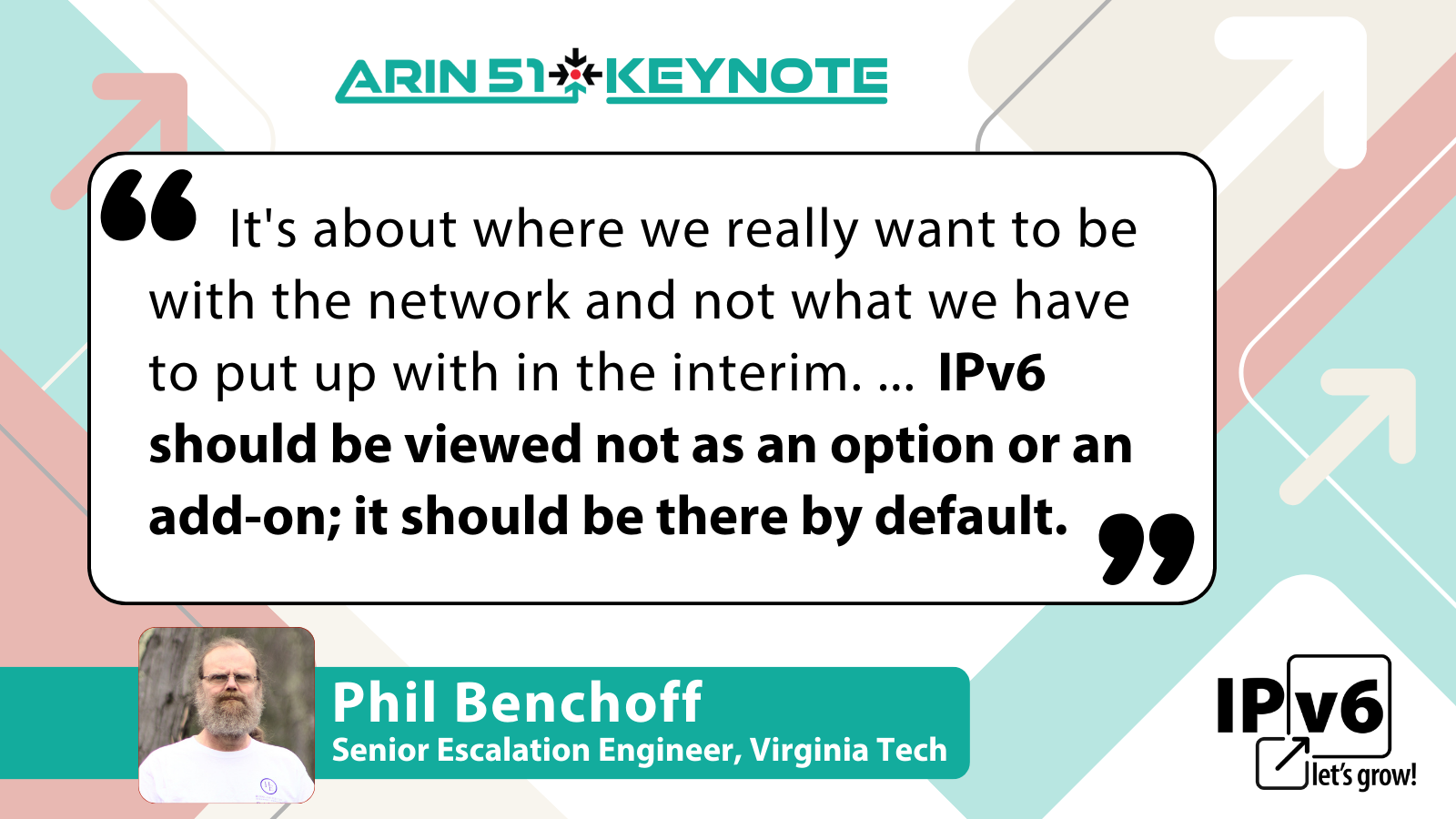
This approach also means only using legacy IP to temporarily fill gaps. Expressing his amazement at how much time at ARIN 51, his first ARIN meeting, was spent dealing with issues related to the scarcity of legacy IP addresses, Phil emphasized the liabilities created by legacy IP: the cost of addresses and the complexity introduced by things like NAT and RFC 1918 addresses.
Phil’s final suggestion for developing the right mindset was to recognize that IPv6 really works today. “You can look at many large mobile carriers, ISPs, and service providers and see that they have IPv6 running everywhere,” he said, “so you can’t really call it experimental or untested.”
Step 2: Test
Moving on to step two in his “IPv6 for Everyone” road map, Phil noted that asking questions and having the right mindset won’t produce results if you don’t also test and, most significantly, test if things work on an IPv6-only network. That way you’ll not only know that the main features of the network work, but also know that management, updates, infrastructure, and support services like DNS, NTP, authentication, and license servers are also available over IPv6. And if a product isn’t quite ready for IPv6? Try to verify that it works with NAT64 and DNS64.
Aim for a Soft Start
Then it came time to discuss getting started (without breaking everything). Phil highlighted the value of a “soft start” — deploying at your network border and incrementally expanding that into the organization — as opposed to a flag day when a global IPv6 switch gets flipped. A soft start allows you to build confidence for and overcome internal resistance to larger deployments by seeing IPv6 actually work on real networks.
The Virginia Tech team, Phil shared, suggests that the engineering and user support networks in particular get IPv6 first. “If you have success there, you’ll build confidence in those people,” Phil said, “and it helps enable yourself to increase deployment.”
Phil then shared an overview of an incremental rollout, beginning with getting addresses and establishing core network routing. Virginia Tech has found the latter to be fairly easy and low risk to legacy IP traffic, given that IPv6 configuration is generally independent of legacy IP routing configuration.
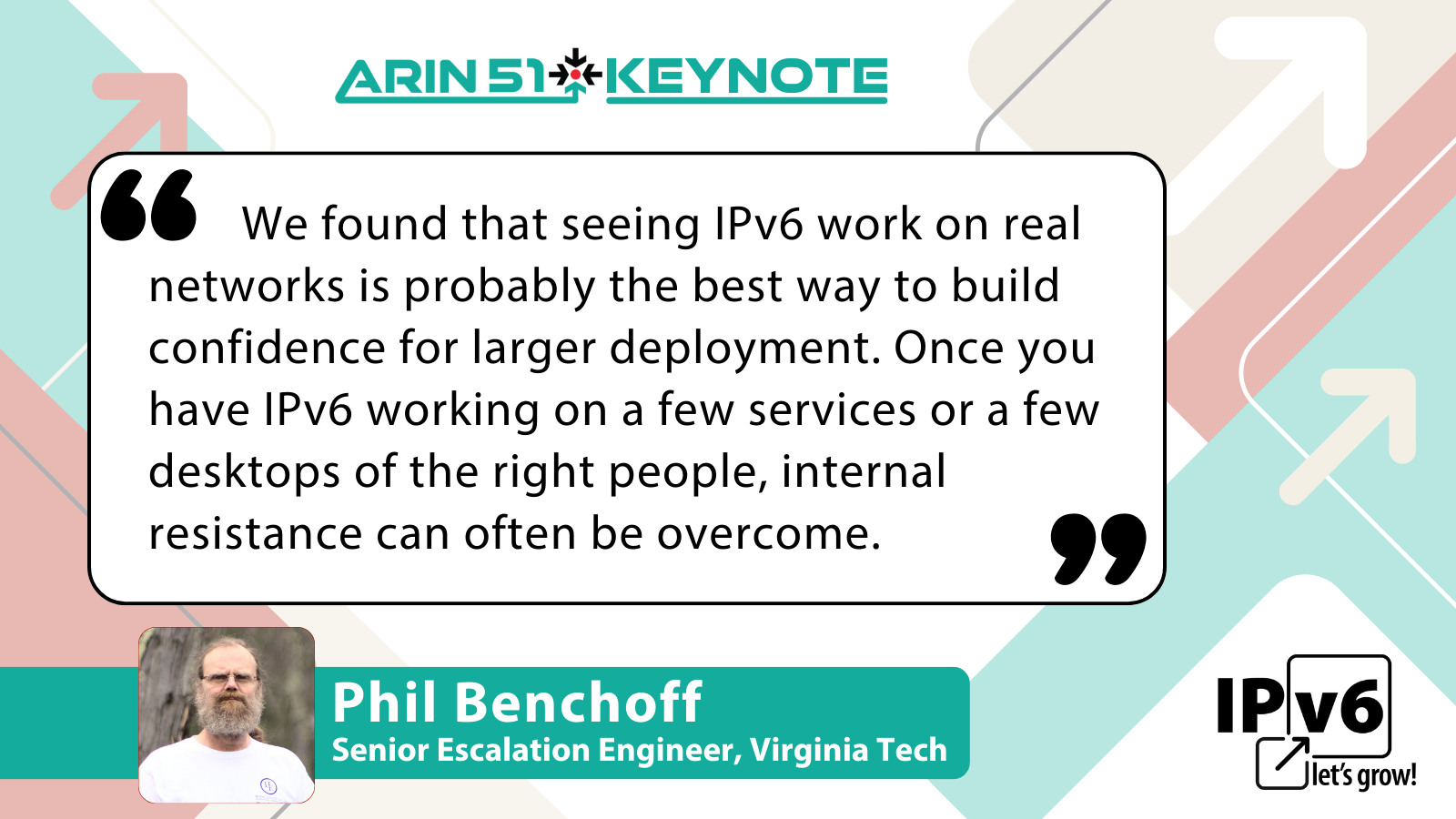
As part of this process, Phil also noted that DNS is key for services and interface configuration is key for clients. You can read his full explanation of short- and long-term DNS best practices, as well as incremental options and protections offered by interfaces and router advertisements, in this section of the keynote transcript.
Things Just Work
Phil concluded his portion of the keynote address by mentioning one other supportive technology — one that helped enable the IPv6 World Launch in 2013. Happy Eyeballs, which has been baked into most browsers and a few other things for more than a decade, attempts legacy IP and IPv6 connections at the same time to avoid the wait for a timeout of one protocol before falling back to the other.
And his final thought was some more reassurance of IPv6’s manageability. “I don’t believe we’ve ever had any problems, at least in more modern times, enabling IPv6 on a user network,” he said. “Things just work, provided your backbone IPv6 connectivity is working.”
A Call to Urgency and Self-Examination
Eric Brown, a member of the engineering team operating Virginia Tech’s IPv6 and legacy networks, took the spotlight next to encourage everyone to help make adopting IPv6 easier for others. He began with a call to urgency and a vision of two different possible futures for IPv6. In the first, we push forward, expending a lot of effort avoiding change, until we run out of rope and face panicked change to IPv6 at the end as large network outages become an all-too-common experience. In the second, we achieve an ideal “soft landing” to full adoption, with no flag day but progressively more organizations deciding to turn off legacy IP as they feel ready and as the market is ready for them. Reliance on legacy IP naturally dwindles, and eventually we simply turn off legacy global routing.
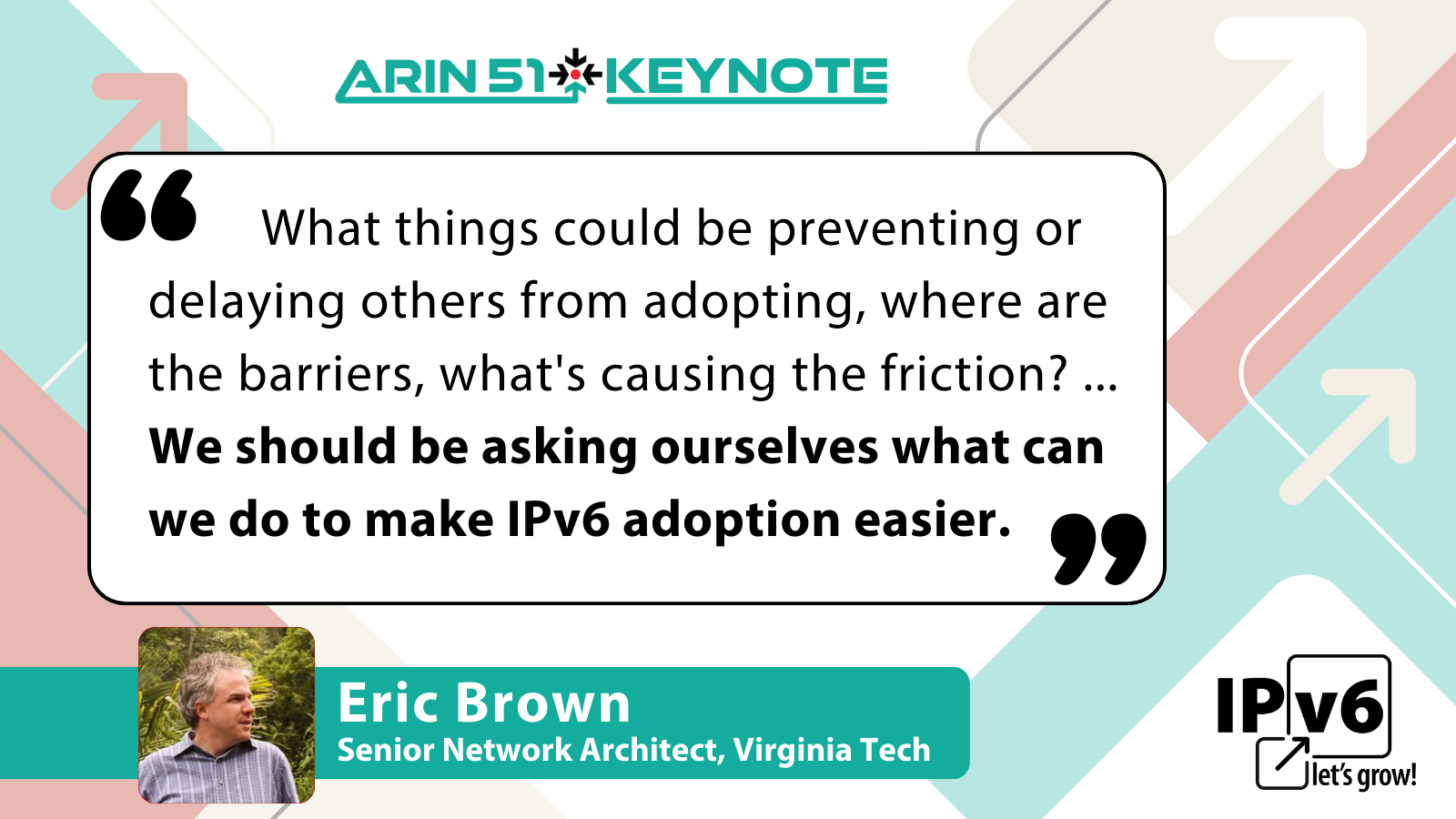
With that in mind, Eric set out on an examination of what could be preventing or delaying others from adopting IPv6. “We should be asking ourselves what we can do to make IPv6 adoption easier,” he said.
Addressing Barriers to Adoption
Eric identified the following aspects of the industry that are acting as points of friction and slowing adoption rates:
- Perverse Economics: While addresses should be a common good administered by the Regional Internet Registries (RIRs), this cannot be so when facing exhaustion of legacy IP address. Noting that the market for address space is necessary to create incentive to free up unused space, Eric pointed to its creation of incentive structures that resist change as the problem. “In this case, the change is to adopting IPv6,” he said. “Unlike most markets, this is a market that was never intended to exist indefinitely … a market that was created to aid the transition in technology now has the potential to resist that very change.”
- Reachability Problems: Next, Eric focused on large transit providers and the differences in IPv6 routing tables between various carriers. The inconsistency in reachability for IPv6 eliminates users’ trust that their traffic will be delivered, which is the basic promise of the Internet. “Let’s find a way to remove this friction,” Eric urged. “Let’s stop weaponizing reachability.”
- Internet Service Providers (ISPs): In many cases, IPv6 still is not available to end users, and, even where it is, other problems exist: nonuniform availability, such as a carrier providing it for residential but not business tiers, and instability of IPv6 prefix delegation. “I am sure there are other problems,” Eric said. “ISPs should take a long, hard look and see if they are causing any.”
- Application Service Providers: Eric asserted that getting application and content providers on the leading edge of enabling services for IPv6 may be the single most impactful change needed to usher in the next phase of adoption — allowing organizations that provide general network service to users and consumers of their content to consider going single stack, which in turn will lead to freeing up of legacy address resources. “IPv6 should be a first-class citizen within the application and content provider,” Eric said. “This starts with management commitment making it de rigueur and advertising it.”
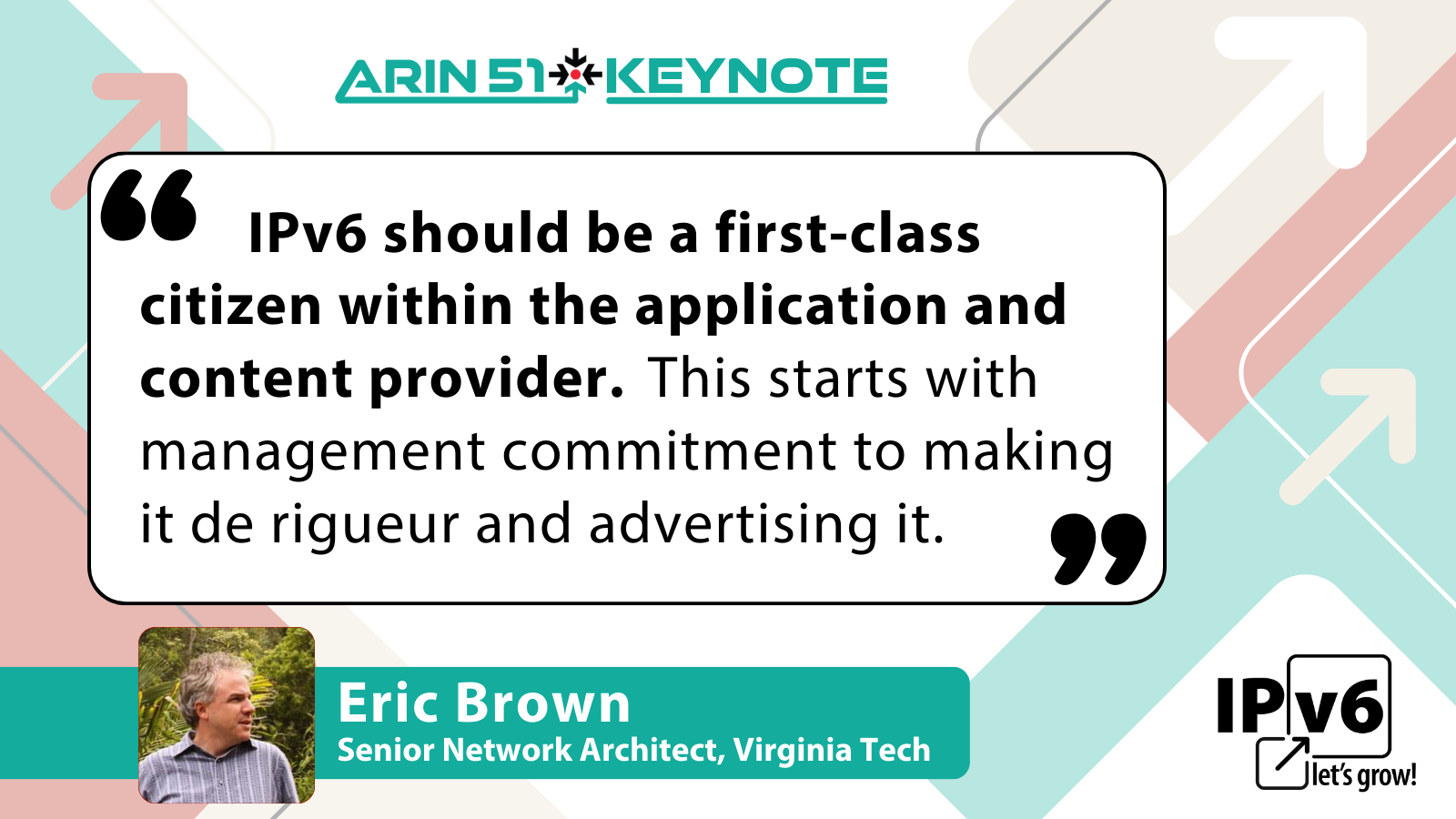
- Network Equipment and Services: While thanking industry vendors for IPv6 support that, for the most part, has become consistently good, Eric highlighted the problem with vendors adjacent to the networking space, where silly problems aren’t being caught in products that purport to support IPv6. He urged these vendors to assume that IPv6 is business critical for their customers and to use their own products in an IPv6 environment so they catch their own mistakes. “If your website isn’t accessible by IPv6, then you’ve already started the relationship you’re trying to establish on the wrong foot,” Eric said. “You’re showing me that IPv6 isn’t important to you.”
- Software: The gold standard is to test software in a single-stack environment across its entire lifecycle and ensure installation, registration, use, and updating all work correctly.
- Users: Eric encouraged end users and operators to help themselves by not being afraid to learn, by seeking out solutions to problems from those who have already gone through IPv6 deployment, and by demanding that vendors support IPv6. “Whatever you do, don’t turn it off as a way to avoid problems,” he said. “Don’t be spooked by IPv6; just turn it on. You’ve already implemented a half-dozen technologies that are more complex in the time IPv6 has been around.”
- Education: A lot of education still teaches networking using legacy IP, and the idea that IPv6 looks scary, before you get to know it, effects people’s decision-making processes.
- Will: The biggest hurdle Eric identified is simply the will to sunset legacy IP and adopt IPv6 despite some (solvable) technical issues. “IPv6 is a proven technology, and it’s ready for business,” he said.
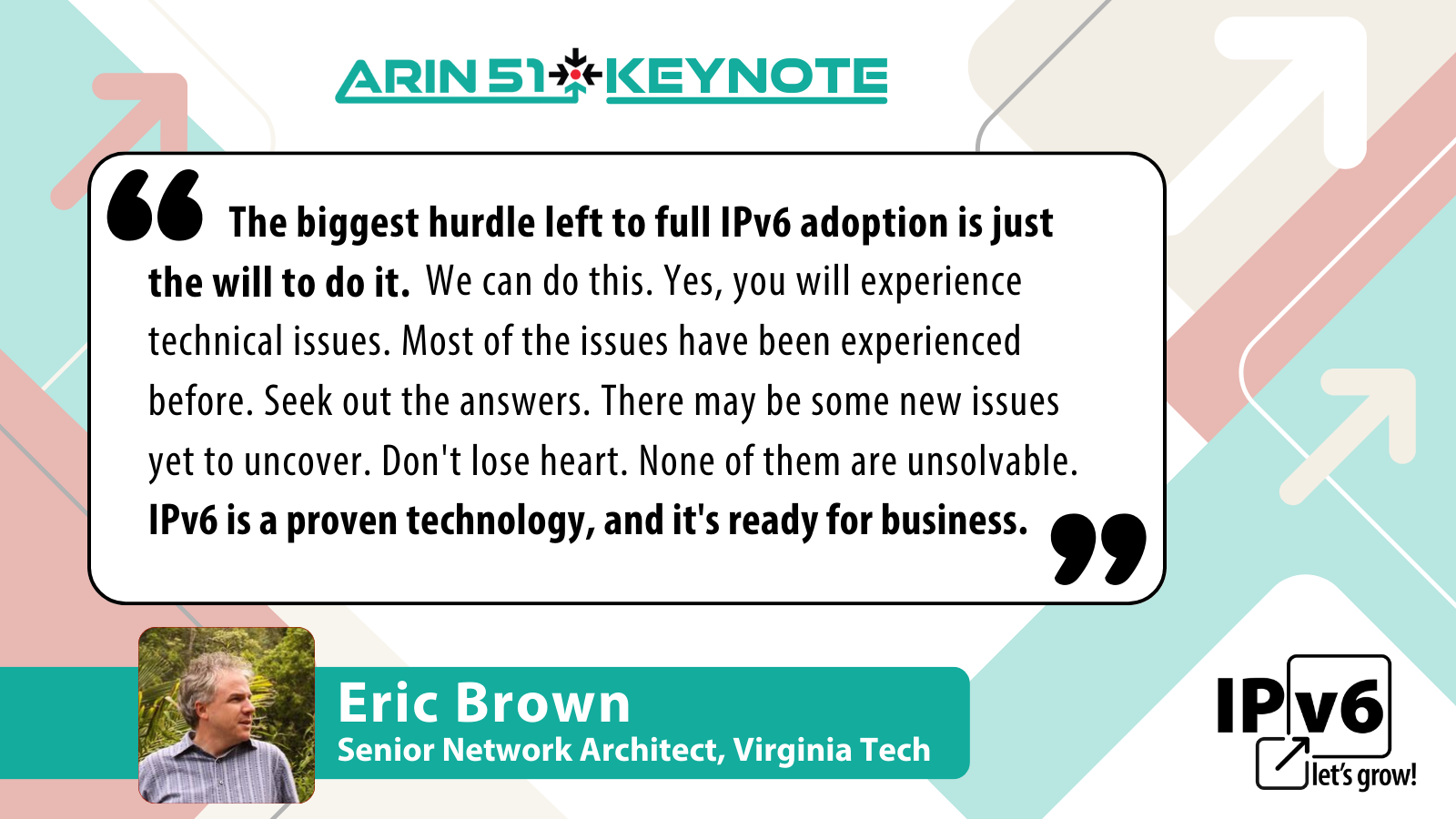
Proof Positive
Dr. Scott Midkiff closed the keynote by thanking Brian Jones for representing Virginia Tech in the ARIN community and on the ARIN Advisory Council and for facilitating this presentation. He also thanked Eric and Phil for their comments, input, and especially their technical contributions over the past 25-plus years. “Thanks again to ARIN for having us,” he concluded, “and we are looking forward to seeing greater adoption and full support for IPv6.”
Richard Jimmerson, ARIN Chief Operations Officer, followed up to thank Virginia Tech and its team for serving as the primary proof positive of IPv6 in production during ARIN’s outreach push to encourage other organizations to deploy it about 15 years ago.
To watch the full keynote address for yourself, check out our ARIN 51 webcast archive or click below to play the video on YouTube. Then let us know about your own experiences, tips, tricks, and other thoughts on IPv6 deployment. Email us at blog@arin.net or find us on social media at @TeamARIN.
Recent blogs categorized under: IPv6
GET THE LATEST!
Sign up to receive the latest news about ARIN and the most pressing issues facing the Internet community.
SIGN ME UP →Blog Categories
ARIN Bits • Tips • Updates • Elections • Caribbean • Outreach • Security • RPKI • Public Policy • Guest Post • Grant Program • Fellowship Program • Data Accuracy • IPv6 • Business Case for IPv6 • Internet Governance • Training • IPv4 • Customer Feedback • IRR


